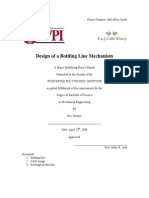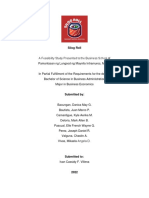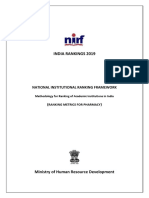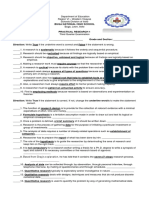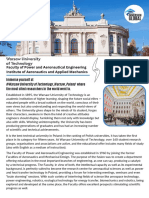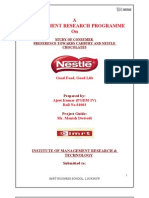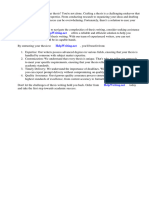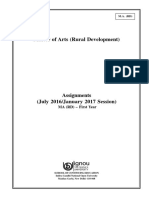Professional Documents
Culture Documents
Development of Learning Instructional Based On 3R (Reduce, Reuse, & Recycle) To Improve Learning's Outcome On Fourth Grade of Elementary School On Environmental Preservation's Material
Uploaded by
Anonymous izrFWiQOriginal Title
Copyright
Available Formats
Share this document
Did you find this document useful?
Is this content inappropriate?
Report this DocumentCopyright:
Available Formats
Development of Learning Instructional Based On 3R (Reduce, Reuse, & Recycle) To Improve Learning's Outcome On Fourth Grade of Elementary School On Environmental Preservation's Material
Uploaded by
Anonymous izrFWiQCopyright:
Available Formats
Volume 4, Issue 7, July – 2019 International Journal of Innovative Science and Research Technology
ISSN No:-2456-2165
Development of Learning Instructional Based On 3R
(Reduce, Reuse, & Recycle) to Improve Learning’s
Outcome on Fourth Grade of Elementary School on
Environmental Preservation’s Material
Priliya Dwi Nurisdiana1 Z.A. Imam Supardi2 Sifak Indana3
Graduate Program of Elementary Education Department,
Universitas Negeri Surabaya
Abstract:- This study aims to (1) produce learning I. INTRODUCTION
instructional based on 3R that is valid, practical, and
effective to improve learning’s outcome of elementary The problem of waste is one of the problems that until
school fourth grade students, (2) describe the validity, now has not been resolved. The amount of garbage is
practicality, and effectiveness of learning instructional increasing every day. Most of the waste is inorganic waste
based on 3R to improve student learning’s outcome on that takes a long time to decompose. Inorganic waste is
Themes 4 Sub Theme 1 Learning 1. dominated by plastic waste originating from food or
beverage packaging of a product and plastic bag. Plastic
This research is a study of the development of waste can pollute the environment if it is not treated
learning instructional using the 4-D development model. properly. Plastics contain toxic additives, coloring agents,
Learning instructional based on 3R are validated by and are also not environmentally friendly. Organic
experts in their fields. The validation results state that chemicals such as dissolved plastics can cause death in fish
learning instructional can be applied. The validated and other aquatic organisms (Darmono, 2006).
learning instructional was tested on fourth grade
students at SDN Wonokusumo I/40 Surabaya. At present there is a vigorous implementation of
plastic waste management by implementing
The results of limited trials show that (1) The environmentally friendly life. These activities can be
learning instructional developed get very valid carried out through the use of waste into goods that have
categories, (2) Practical learning instructional based on use value as an effort to preserve the environment 3R,
the feasibility of lesson plans with very good categories namely Reduce, Reuse, and Recycle. 3R activities up to
and active students in learning activities, (3) Learning now are still the best way to manage and handle waste with
instructional are declared effective based on domain a variety of problems. Waste management with the 3R
learning’s outcome knowledge who get completeness of system can be implemented by everyone in their daily
88.2%, in the attitude domain get results 90% of activities.
students have very good attitude, and completeness of
85.3% in the skill domain, and get excellent student Based on the results of observations, the results
responses. showed that environmental preservation activities for fourth
grade students of SDN Wonokusumo I/40 Surabaya had
Thus it can be concluded that learning gone quite well. This is because students are actively
instructional based on 3R are valid, practical, and involved in maintaining cleanliness and environmental
effective to be used to improve learning’s outcome of 4th sustainability. Scheduled students have already carried out
grade elementary school students on environmental the “Ngosek Bersama” activity, community service, and
preservation’s material. activities that support zero waste. In addition, students also
have a responsibility to maintain class cleanliness and care
Keywords:- Learning Instructional, 3R (Reduce, Reuse, and for plants in the classroom environment. But another fact
Recycle), Learning’s Outcome. was found, namely that there were still many trash piles in
the trash and not infrequently there were still many students
who did not care about the environment. The increasing
amount of waste is a problem that still cannot be found a
solution.
Meanwhile, based on the results of interviews with
fourth grade teachers in SDN Wonokusumo I/40 Surabaya,
data on student learning’s outcome in science subjects were
obtained in environmental conservation material, which
amounted to 71,5. This shows that the learning’s outcome
IJISRT19JL183 www.ijisrt.com 173
Volume 4, Issue 7, July – 2019 International Journal of Innovative Science and Research Technology
ISSN No:-2456-2165
of class IV students are still considered low because they being treated. The research design by Fraenkel, Wallen, and
obtain grades under the minimum completion criteria that Hyun (2012) is described as follows:
have been set by the school, which is 75 in science subjects.
Based on the problems found in fourth grade students
of SDN Wonokusumo I/40 Surabaya, 3R activities are
suitable to be inserted in learning activities. This is because
3R-based learning will be able to improve student
learning’s outcome on environmental preservation material. Fig 1
Therefore the researcher wants to conduct a research
"Development of Learning Instruction Based on 3R Data analysis techniques are carried out to process
(Reduce, Reuse, & Recycle) to Improve Learning’s data obtained from the results of trials so that the learning
Outcome on Fourth Grade of Elementary School on instructional used in learning activities can be known
Environmental Preservation’s Material". validity, practicality, and effectiveness. Data from the
research results analyzed include the validity of learning
II. METHOD instructional, learning’s outcome tests, student response
questionnaires, readability of teaching materials,
This research is a development research using a 4-D observation sheet of lesson plan implementation, student
model without the dissimination stage. This study activity sheets, and obstacles that arise during learning
developed learning instructional based on 3R (Reduce, activities
Reuse, and Recycle) to improve the learning’s outcome of
4th grade elementary school students on environmental Data from the research results to be analyzed are as
preservation materials. follows:
The study was conducted at SDN Wonokusumo I/40 A. Analysis of Learning instructional Validation Results
Surabaya in 4th A 2018/2019 school year, which amounted Validation of learning instructional consists of
to 34 students, consisting of 15 male students and 19 Syllabus, Lesson Plan, Teaching Materials, Student
female students. Activity Sheets, and Learning’s Outcome Test. The results
of the validation of the learning instructional were then
Trial of learning instructional developed using One analyzed in quantitative descriptive, by calculating the
Group Pretest-Posttest Design. The trial design in this study average score of the assessment from the validator. The
using one group will be given a pretest and posttest after average score obtained is converted using the following
conditions:
Validation Score Interval Category Information
3,6 ≤ SV ˂ 4 Very Valid Can be used without revision
2,6 ≤ SV ˂ 3,5 Valid Can be used with a slight revision
1,6 ≤ SV ˂ 2,5 Less Valid Can be used with many revisions
0,6 ≤ SV ˂ 1,5 Invalid Cannot be used, it still requires consultation
Table 1:- Criteria for categorizing the validity of learning instructional
(Ratumanan & Laurens, 2011)
B. Readability Analysis of Teaching Materials C. Analysis of Lesson Plan
The reading of teaching materials is done by filling Data on the implementation of the lesson plan was
out the questionnaire and to measure the readability of analyzed descriptively quantitatively, namely by
teaching materials the following formula is used. calculating the score of the observations and then looking
for percentages related to the implementation of the
learning stages in the lesson plan carried out by the teacher
during the learning activities. Calculation of the percentage
of implementation of lesson plan is calculated using the
following formula:
Information:
P = Readability percentage
∑ K = Number of students who choose yes or no answers
∑N = Number of students who fill in the
questionnaire
IJISRT19JL183 www.ijisrt.com 174
Volume 4, Issue 7, July – 2019 International Journal of Innovative Science and Research Technology
ISSN No:-2456-2165
Information: The criteria related to the percentage of
implementation of the lesson plan use the provisions in the
P = Percentage of Implementation from Lesson Plan table below.
Interval Category
0% ≤ P ≤ 25% Not implemented
25% ≤ P ≤ 50% Poorly implemented
50% ≤ P ≤ 75% Well done
75% ≤ P ≤ 100% Very well done
Table 2:- Criteria for Percentage of Implementation of Lesson Plan
(Riduwan, 2012)
D. Analysis of Student Activities In determining the improvement of student learning’s
Student activity data is taken from student activities outcome, used Normalized Gain student learning’s
seen during the learning activities. The percentage of outcome. The increase or gain is calculated using the
student activity is calculated using the following formula. following formula.
Information: Information:
P = Percentage of Student Activities g (gain) = Increased Learning’s outcome
Tse = Number of activities shown by students Spre = Pretest score (initial learning result)
N = Number of all activities Spost = Posttest score (final learning result)
(Akbar, 2012) (Hake, 1999)
E. Analysis of Learning’s Outcome Tests The categories related to gain scores refer to the
following table.
n-gain Category
(g) > 0,7 High
0,7 ≥ (g) ≤ 0,3 Medium
(g) ˂ 0,3 Low
Table 3:- N-gain category
III. RESULTS AND DISCUSSION The practicality of learning instructional is seen based
on the implementation of lesson plan in learning activities.
The validity of the developed learning instructional is The implementation of the learning instructional was
obtained from the validity of the validator. With the observed by two observers in 3 meetings. All stages of
following description, the syllabus has a very valid activities listed in the lesson plan were carried out in the
category with a percentage of agreement of 91.8%, lesson trial with percentage of agreement amounting to 92.9%
plan has a very valid category with a percentage of with a very good category. The activities of students get a
agreement of 95.9%, teaching materials that have a very very good category with the percentage of student activities
valid category with a percentage of agreement of 89.6%, amounting to 86.3%. While the readability of teaching
student activity sheets has a very valid category with a materials generally gets a positive response from students
percentage of agreement of 95.9%. Meanwhile knowledge of 93.25%.
learning’s outcome test developed has a very valid category
with a percentage of agreement on aspects of content Meanwhile, to measure the effectiveness of learning
validation at 98.1%, while 96.2% on aspects of language instructional, learning test results are used. Learning’s
and question writing. Attitude domain learning test results outcome tests are given to students before learning
get a very valid category with a percentage of agreement of activities in the form of pretest questions and after learning
91.4% and skill domain learning’s outcome tests get a valid activities in the form of posttest questions. The results
category with a percentage of agreement of 89.3%. obtained from the pretest and posttest are presented in table
4 below.
IJISRT19JL183 www.ijisrt.com 175
Volume 4, Issue 7, July – 2019 International Journal of Innovative Science and Research Technology
ISSN No:-2456-2165
Student’s Code Pretest Posttest
N-gain K.
Value Ket. Value Ket.
S1 80 T 100 T 1.0 High
S2 80 T 100 T 1.0 High
S3 67 TT 93 T 0.8 High
S4 40 TT 93 T 0.9 High
S5 47 TT 100 T 1.0 High
S6 33 TT 93 T 0.9 High
S7 40 TT 80 TT 0.7 High
S8 47 TT 80 T 0.6 Medium
S9 40 TT 87 T 0.8 High
S10 27 TT 67 TT 0.5 Medium
S11 67 TT 100 T 1.0 High
S12 53 TT 87 T 0.7 High
S13 60 TT 93 T 0.8 High
S14 60 TT 93 T 0.8 High
S15 27 TT 93 T 0.9 High
S16 80 T 100 T 1.0 High
S17 60 TT 93 T 0.8 High
S18 33 TT 80 T 0.7 High
S19 80 T 93 T 0.7 High
S20 80 T 100 T 1.0 High
S21 33 TT 93 T 0.9 High
S22 47 TT 93 T 0.9 High
S23 73 TT 100 T 1.0 High
S24 53 TT 100 T 1.0 High
S25 27 TT 67 TT 0.5 Medium
S26 67 TT 100 T 1.0 High
S27 33 TT 73 TT 0.6 Medium
S28 67 TT 87 T 0.6 Medium
S29 47 TT 80 T 0.6 Medium
S30 80 T 93 T 0.7 High
S31 27 TT 93 T 0.9 High
S32 33 TT 93 T 0.9 High
S33 33 TT 87 T 0.8 High
S34 33 TT 80 T 0.7 High
The number of students who did The number of students who
28 4
not complete did not complete
The number of students who The number of students who
6 30
complete complete
Percentage of completeness
Percentage of completeness (%) 17,6% 88,2%
(%)
Table 4:- Result of Pretest and Posttest
Information: Recycle), there was an increase in the percentage of
completeness, 88.2% of students who achieved minimum
T = Complete completion criteria were seen from the posttest results.
TT = Incomplete
Ket. = Learning’s outcome in the attitude domain are given
Information to students in the form of filling in the self-assessment
K = Category sheet by each student. The acquisition of student learning’s
outcome in the attitude domain is divided into two, namely
The minimum completion criteria set at 4th SDN spiritual attitudes and social attitudes. In the spiritual
Wonokusumo I/40 Surabaya in 4th grade is 75. In table 4 attitude, results show that 90% of students have very good
shows that the percentage of mastery learning at pretest is attitude. Whereas in the social aspect, it was found that
17.6%, which means that most students have not reached 85% of students had good attitude, so it could be concluded
the specified minimum completion criteria. Meanwhile that the majority of students had attitude categories both on
after the implementation of learning activities by applying spiritual attitudes and social attitudes.
learning instructional based on 3R (Reduce, Reuse, and
IJISRT19JL183 www.ijisrt.com 176
Volume 4, Issue 7, July – 2019 International Journal of Innovative Science and Research Technology
ISSN No:-2456-2165
Learning’s outcome in the skill domain are obtained students in groups during learning activities. The results
from the assessment of posters that have been made by obtained from are presented in the following table.
Rated Aspect
Student’s Code Poster Complete of Poster Score Value K Ket.
Poster Clarity
Contents Information
S1 4,0 4,0 3,0 11,0 91,7 SB T
S2 2,0 3,0 3,0 8,0 66,7 C TT
S3 2,0 3,0 3,0 8,0 66,7 C TT
S4 4,0 3,0 4,0 11,0 91,7 SB T
S5 4,0 3,0 4,0 11,0 91,7 SB T
S6 4,0 4,0 3,0 11,0 91,7 SB T
S7 4,0 3,0 3,0 10,0 83,3 B T
S8 2,0 3,0 3,0 8,0 66,7 C TT
S9 4,0 3,0 3,0 10,0 83,3 B T
S10 2,0 3,0 3,0 8,0 66,7 C TT
S11 4,0 4,0 3,0 11,0 91,7 SB T
S12 4,0 4,0 3,0 11,0 91,7 SB T
S13 4,0 3,0 4,0 11,0 91,7 SB T
S14 4,0 4,0 3,0 11,0 91,7 SB T
S15 4,0 3,0 4,0 11,0 91,7 SB T
S16 4,0 4,0 3,0 11,0 91,7 SB T
S17 4,0 4,0 3,0 11,0 91,7 SB T
S18 2,0 3,0 3,0 8,0 66,7 C TT
S19 4,0 3,0 4,0 11,0 91,7 SB T
S20 4,0 3,0 3,0 10,0 83,3 B T
S21 4,0 4,0 3,0 11,0 91,7 SB T
S22 4,0 4,0 3,0 11,0 91,7 SB T
S23 4,0 3,0 4,0 11,0 91,7 SB T
S24 4,0 3,0 4,0 11,0 91,7 SB T
S25 4,0 3,0 3,0 10,0 83,3 B T
S26 4,0 3,0 3,0 10,0 83,3 B T
S27 4,0 3,0 4,0 11,0 91,7 SB T
S28 4,0 3,0 3,0 10,0 83,3 B T
S29 4,0 3,0 4,0 11,0 91,7 SB T
S30 4,0 3,0 3,0 10,0 83,3 B T
S31 4,0 4,0 3,0 11,0 91,7 SB T
S32 4,0 3,0 3,0 10,0 83,3 B T
S33 4,0 3,0 3,0 10,0 83,3 B T
S34 4,0 3,0 3,0 10,0 83,3 B T
The number of students who did not complete 5
The number of students who complete 29
Percentage of completeness 85,3%
Table 5:- Learning’s outcome of Skill Domain
Information: that most students can participate in learning activities well
and can achieve learning goals.
K = Ket =
Category Information The response of the students in question is students
SB = Very T = Complete towards learning activities by applying learning
Good TT = instructional based on 3R. Student responses are measured
B = Good Incomplete using a questionnaire given when learning activities end.
C = Enough The results of student responses by applying the 3R-based
learning instructional in 4th grade SDN Wonokusumo I/40
Based on the data in table 5, the results show that Surabaya generally received a very good response with the
85.3% of students have achieved minimum completion percentage of student responses of 94%. This shows that
criteria in the skill domains learning’s outcome. This shows overall learning activities by implementing learning
IJISRT19JL183 www.ijisrt.com 177
Volume 4, Issue 7, July – 2019 International Journal of Innovative Science and Research Technology
ISSN No:-2456-2165
instructional based on 3R can attract students motivation in REFERENCES
learning activities.
[1]. Akbar, Sa’dun. 2013. Instrumen Perangkat
IV. CONCLUSION Pembelajaran. Bandung: Rosdakarya.
[2]. Darmono. 2006. Lingkungan Hidup dan Pencemaran
The validity of the learning instructional developed is : Hubungannya dengan Toksikologi Senyawa Logam.
seen from the results of the validity carried out by the Jakarta: UI – Press.
validator. The learning instructional developed was [3]. Fraenkel, J.R., Wallen, N. E., Hyun, H. (2012). How
declared valid and feasible to use after getting advice and to Design and Evaluate Research in Education 8th
input from the validator. The practicality of the learning Edition. New York: Mc Graw Hill.
instructional developed can be seen from the [4]. Hake, Richard R. (1999). American Educational
implementation of the lesson plan, as a whole the learning Research Association's Division D, Measurement and
activities went very well. The most dominant student Research Methodology: Analyzing Change/Gain
activity in 3R-based learning activities is working with Scores. http://www.psysicsindiana.edu/sdi/Analyzing-
group members. While the obstacles found when research Change-Gain.pdf.
can be overcome through discussion with observers. [5]. Mahanal, Susriyati, dkk. 2009. Pendidikan
Lingkungan Hidup Untuk Sekolah Dasar Kelas V Jilid
The practicality of learning instructional based on 3R 5. Malang: Pusat Penelitian Lingkungan Hidup
(Reduce, Reuse, and Recycle) in the study was declared Lembaga Penelitian Universitas Negeri Malang.
practical based on the feasibility of lesson plans, student [6]. Ratumanan, T. G., & Laurens, T. (2011). Penilaian
activities, student responses, and readability of teaching Hasil Belajar pada Tingkat Satuan Pendidikan Edisi
materials. The implementation of learning received a very 2. Surabaya: Unesa University Press.
good category with a percentage of agreement of 92.9%. [7]. Riduwan. (2012). Skala Pengukuran Variabel-
The activities of students get a very good category with the Variabel Penelitian. Bandung: Alfabeta.
percentage of student activities amounting to 86.3%. While [8]. Utaya, Sugeng, dkk. 2009. Pendidikan Lingkungan
the readability of teaching materials generally gets a Hidup Untuk Sekolah Dasar Kelas VI Jilid 6. Malang:
positive response from students of 93.25%. Pusat Penelitian Lingkungan Hidup Lembaga
Penelitian Universitas Negeri Malang.
The effectiveness of the learning instructional [9]. Yurimoto, Katsumi. 2017. Oh, ternyata Kita Bisa
developed can be seen from the completeness of the Melakukan Kegiatan 3R (Reduce, Reuse, dan Recycle)
learning’s outcome of student learning’s outcome tests in untuk Mengurangi Sampah!. Jakarta: PT Gramedia
the knowledge realm of obtaining completeness of 88.2%, Pustaka Utama.
the attitude domain obtaining 90% of students having very
good attitude, and 85.3% of students achieving minimum
completion criteria in the results learning skill realm.
Meanwhile the responses of students get a very good
category with the percentage of students' responses
amounting to 94%.
Based on the findings of the research results it can be
concluded that the learning instructional based on 3R
(Reduce, Reuse, and Recycle) that are developed are
feasible to improve student learning’s outcome.
SUGGESTION
Based on the results of the research that has been
carried out, there are several suggestions as follows.
Need evaluation in managing time allocation in learning
activities.
The development of learning instructional based on 3R
(Reduce, Reuse, and Recycle) needs to be developed
and implemented consistently.
IJISRT19JL183 www.ijisrt.com 178
You might also like
- The Subtle Art of Not Giving a F*ck: A Counterintuitive Approach to Living a Good LifeFrom EverandThe Subtle Art of Not Giving a F*ck: A Counterintuitive Approach to Living a Good LifeRating: 4 out of 5 stars4/5 (5794)
- Evaluation of Assessing The Purity of Sesame Oil Available in Markets of India Using Bellier Turbidity Temperature Test (BTTT)Document4 pagesEvaluation of Assessing The Purity of Sesame Oil Available in Markets of India Using Bellier Turbidity Temperature Test (BTTT)Anonymous izrFWiQNo ratings yet
- The Little Book of Hygge: Danish Secrets to Happy LivingFrom EverandThe Little Book of Hygge: Danish Secrets to Happy LivingRating: 3.5 out of 5 stars3.5/5 (399)
- Analysis of Ancol Beach Object Development Using Business Model Canvas ApproachDocument8 pagesAnalysis of Ancol Beach Object Development Using Business Model Canvas ApproachAnonymous izrFWiQNo ratings yet
- Shoe Dog: A Memoir by the Creator of NikeFrom EverandShoe Dog: A Memoir by the Creator of NikeRating: 4.5 out of 5 stars4.5/5 (537)
- Teacher Leaders' Experience in The Shared Leadership ModelDocument4 pagesTeacher Leaders' Experience in The Shared Leadership ModelAnonymous izrFWiQNo ratings yet
- Closure of Midline Diastema by Multidisciplinary Approach - A Case ReportDocument5 pagesClosure of Midline Diastema by Multidisciplinary Approach - A Case ReportAnonymous izrFWiQNo ratings yet
- Never Split the Difference: Negotiating As If Your Life Depended On ItFrom EverandNever Split the Difference: Negotiating As If Your Life Depended On ItRating: 4.5 out of 5 stars4.5/5 (838)
- Bioadhesive Inserts of Prednisolone Acetate For Postoperative Management of Cataract - Development and EvaluationDocument8 pagesBioadhesive Inserts of Prednisolone Acetate For Postoperative Management of Cataract - Development and EvaluationAnonymous izrFWiQNo ratings yet
- Hidden Figures: The American Dream and the Untold Story of the Black Women Mathematicians Who Helped Win the Space RaceFrom EverandHidden Figures: The American Dream and the Untold Story of the Black Women Mathematicians Who Helped Win the Space RaceRating: 4 out of 5 stars4/5 (895)
- Knowledge and Utilisation of Various Schemes of RCH Program Among Antenatal Women and Mothers Having Less Than Five Child in A Semi-Urban Township of ChennaiDocument5 pagesKnowledge and Utilisation of Various Schemes of RCH Program Among Antenatal Women and Mothers Having Less Than Five Child in A Semi-Urban Township of ChennaiAnonymous izrFWiQNo ratings yet
- The Yellow House: A Memoir (2019 National Book Award Winner)From EverandThe Yellow House: A Memoir (2019 National Book Award Winner)Rating: 4 out of 5 stars4/5 (98)
- Design and Analysis of Humanitarian Aid Delivery RC AircraftDocument6 pagesDesign and Analysis of Humanitarian Aid Delivery RC AircraftAnonymous izrFWiQNo ratings yet
- A Heartbreaking Work Of Staggering Genius: A Memoir Based on a True StoryFrom EverandA Heartbreaking Work Of Staggering Genius: A Memoir Based on a True StoryRating: 3.5 out of 5 stars3.5/5 (231)
- Investigations On BTTT As Qualitative Tool For Identification of Different Brands of Groundnut Oils Available in Markets of IndiaDocument5 pagesInvestigations On BTTT As Qualitative Tool For Identification of Different Brands of Groundnut Oils Available in Markets of IndiaAnonymous izrFWiQNo ratings yet
- Grit: The Power of Passion and PerseveranceFrom EverandGrit: The Power of Passion and PerseveranceRating: 4 out of 5 stars4/5 (588)
- Experimental Investigation On Performance of Pre-Mixed Charge Compression Ignition EngineDocument5 pagesExperimental Investigation On Performance of Pre-Mixed Charge Compression Ignition EngineAnonymous izrFWiQNo ratings yet
- Elon Musk: Tesla, SpaceX, and the Quest for a Fantastic FutureFrom EverandElon Musk: Tesla, SpaceX, and the Quest for a Fantastic FutureRating: 4.5 out of 5 stars4.5/5 (474)
- Incidence of Temporary Threshold Shift After MRI (Head and Neck) in Tertiary Care CentreDocument4 pagesIncidence of Temporary Threshold Shift After MRI (Head and Neck) in Tertiary Care CentreAnonymous izrFWiQNo ratings yet
- On Fire: The (Burning) Case for a Green New DealFrom EverandOn Fire: The (Burning) Case for a Green New DealRating: 4 out of 5 stars4/5 (73)
- Platelet-Rich Plasma in Orthodontics - A ReviewDocument6 pagesPlatelet-Rich Plasma in Orthodontics - A ReviewAnonymous izrFWiQNo ratings yet
- Team of Rivals: The Political Genius of Abraham LincolnFrom EverandTeam of Rivals: The Political Genius of Abraham LincolnRating: 4.5 out of 5 stars4.5/5 (234)
- SWOT Analysis and Development of Culture-Based Accounting Curriculum ModelDocument11 pagesSWOT Analysis and Development of Culture-Based Accounting Curriculum ModelAnonymous izrFWiQNo ratings yet
- Women in The Civil Service: Performance, Leadership and EqualityDocument4 pagesWomen in The Civil Service: Performance, Leadership and EqualityAnonymous izrFWiQNo ratings yet
- The Emperor of All Maladies: A Biography of CancerFrom EverandThe Emperor of All Maladies: A Biography of CancerRating: 4.5 out of 5 stars4.5/5 (271)
- Securitization of Government School Building by PPP ModelDocument8 pagesSecuritization of Government School Building by PPP ModelAnonymous izrFWiQNo ratings yet
- The Hard Thing About Hard Things: Building a Business When There Are No Easy AnswersFrom EverandThe Hard Thing About Hard Things: Building a Business When There Are No Easy AnswersRating: 4.5 out of 5 stars4.5/5 (344)
- IJISRT19AUG928Document6 pagesIJISRT19AUG928Anonymous izrFWiQNo ratings yet
- Devil in the Grove: Thurgood Marshall, the Groveland Boys, and the Dawn of a New AmericaFrom EverandDevil in the Grove: Thurgood Marshall, the Groveland Boys, and the Dawn of a New AmericaRating: 4.5 out of 5 stars4.5/5 (266)
- IJISRT19AUG928Document6 pagesIJISRT19AUG928Anonymous izrFWiQNo ratings yet
- Child Rights Violation and Mechanism For Protection of Children Rights in Southern Africa: A Perspective of Central, Eastern and Luapula Provinces of ZambiaDocument13 pagesChild Rights Violation and Mechanism For Protection of Children Rights in Southern Africa: A Perspective of Central, Eastern and Luapula Provinces of ZambiaAnonymous izrFWiQNo ratings yet
- Comparison of Continuum Constitutive Hyperelastic Models Based On Exponential FormsDocument8 pagesComparison of Continuum Constitutive Hyperelastic Models Based On Exponential FormsAnonymous izrFWiQNo ratings yet
- Application of Analytical Hierarchy Process Method On The Selection Process of Fresh Fruit Bunch Palm Oil SupplierDocument12 pagesApplication of Analytical Hierarchy Process Method On The Selection Process of Fresh Fruit Bunch Palm Oil SupplierAnonymous izrFWiQNo ratings yet
- Enhanced Opinion Mining Approach For Product ReviewsDocument4 pagesEnhanced Opinion Mining Approach For Product ReviewsAnonymous izrFWiQNo ratings yet
- The Unwinding: An Inner History of the New AmericaFrom EverandThe Unwinding: An Inner History of the New AmericaRating: 4 out of 5 stars4/5 (45)
- Effect Commitment, Motivation, Work Environment On Performance EmployeesDocument8 pagesEffect Commitment, Motivation, Work Environment On Performance EmployeesAnonymous izrFWiQNo ratings yet
- The World Is Flat 3.0: A Brief History of the Twenty-first CenturyFrom EverandThe World Is Flat 3.0: A Brief History of the Twenty-first CenturyRating: 3.5 out of 5 stars3.5/5 (2219)
- Assessment of Health-Care Expenditure For Health Insurance Among Teaching Faculty of A Private UniversityDocument7 pagesAssessment of Health-Care Expenditure For Health Insurance Among Teaching Faculty of A Private UniversityAnonymous izrFWiQNo ratings yet
- Risk Assessment: A Mandatory Evaluation and Analysis of Periodontal Tissue in General Population - A SurveyDocument7 pagesRisk Assessment: A Mandatory Evaluation and Analysis of Periodontal Tissue in General Population - A SurveyAnonymous izrFWiQNo ratings yet
- A Wave Energy Generation Device Using Impact Force of A Breaking Wave Based Purely On Gear CompoundingDocument8 pagesA Wave Energy Generation Device Using Impact Force of A Breaking Wave Based Purely On Gear CompoundingAnonymous izrFWiQNo ratings yet
- The Gifts of Imperfection: Let Go of Who You Think You're Supposed to Be and Embrace Who You AreFrom EverandThe Gifts of Imperfection: Let Go of Who You Think You're Supposed to Be and Embrace Who You AreRating: 4 out of 5 stars4/5 (1090)
- Exam Anxiety in Professional Medical StudentsDocument5 pagesExam Anxiety in Professional Medical StudentsAnonymous izrFWiQ100% (1)
- Pharmaceutical Waste Management in Private Pharmacies of Kaski District, NepalDocument23 pagesPharmaceutical Waste Management in Private Pharmacies of Kaski District, NepalAnonymous izrFWiQNo ratings yet
- To Estimate The Prevalence of Sleep Deprivation and To Assess The Awareness & Attitude Towards Related Health Problems Among Medical Students in Saveetha Medical CollegeDocument4 pagesTo Estimate The Prevalence of Sleep Deprivation and To Assess The Awareness & Attitude Towards Related Health Problems Among Medical Students in Saveetha Medical CollegeAnonymous izrFWiQNo ratings yet
- The Sympathizer: A Novel (Pulitzer Prize for Fiction)From EverandThe Sympathizer: A Novel (Pulitzer Prize for Fiction)Rating: 4.5 out of 5 stars4.5/5 (119)
- Revived Article On Alternative Therapy For CancerDocument3 pagesRevived Article On Alternative Therapy For CancerAnonymous izrFWiQNo ratings yet
- Trade Liberalization and Total Factor Productivity of Indian Capital Goods IndustriesDocument4 pagesTrade Liberalization and Total Factor Productivity of Indian Capital Goods IndustriesAnonymous izrFWiQNo ratings yet
- The Influence of Benefits of Coastal Tourism Destination On Community Participation With Transformational Leadership ModerationDocument9 pagesThe Influence of Benefits of Coastal Tourism Destination On Community Participation With Transformational Leadership ModerationAnonymous izrFWiQNo ratings yet
- The Role of Technology and Informatics in Disaster Planning and Response The Role of TechnologyDocument26 pagesThe Role of Technology and Informatics in Disaster Planning and Response The Role of TechnologyDabon RusselNo ratings yet
- Ef Epi S 2015 EnglishDocument20 pagesEf Epi S 2015 Englishapi-291300079No ratings yet
- Schonert-Reichl-Educating The Heart As Well As The MindDocument7 pagesSchonert-Reichl-Educating The Heart As Well As The MindnewoldnoneNo ratings yet
- Concept Note Template (For Graduate Research)Document2 pagesConcept Note Template (For Graduate Research)Saroj Koirala100% (6)
- Auto Bottle Rejection Conveyor BeltDocument113 pagesAuto Bottle Rejection Conveyor Beltbalabooks100% (2)
- Group 1 - CBM 0009 3Document97 pagesGroup 1 - CBM 0009 3Franck Jeremy MoogNo ratings yet
- CHAPTER II LIT REVIEW FORMATDocument7 pagesCHAPTER II LIT REVIEW FORMATJohn Lester M. Dela CruzNo ratings yet
- Examples of AI Use in Legal Tasks Like Document AnalysisDocument4 pagesExamples of AI Use in Legal Tasks Like Document AnalysisSHOURASENI CHAKRABORTYNo ratings yet
- Her Body and Other Parties: StoriesFrom EverandHer Body and Other Parties: StoriesRating: 4 out of 5 stars4/5 (821)
- Global Developer Population Report - Community EditionDocument23 pagesGlobal Developer Population Report - Community EditionM Asep SyahroniNo ratings yet
- NIRF Metrics For PharmacyDocument25 pagesNIRF Metrics For PharmacyParimalakrishnanNo ratings yet
- Unit 8 FinalDocument3 pagesUnit 8 FinalAllyson CarlosNo ratings yet
- 3rd Quarter - Research 1Document3 pages3rd Quarter - Research 1Hpesoj SemlapNo ratings yet
- Warsaw University of Technology Immersion Program DetailsDocument4 pagesWarsaw University of Technology Immersion Program DetailsLaxmi WankhedeNo ratings yet
- ResearchDocument12 pagesResearchErms Delos Santos BurgosNo ratings yet
- Literature Review On Wireless LanDocument4 pagesLiterature Review On Wireless Lanea8r2tyk100% (1)
- Fajar Imam 20613370 LiterasiDocument66 pagesFajar Imam 20613370 LiterasiSefira PujaNo ratings yet
- MRP Project (MANAGEMENT RESEARCH PROGRAMME) by Ajeet Samrik. IMRT, LkoDocument53 pagesMRP Project (MANAGEMENT RESEARCH PROGRAMME) by Ajeet Samrik. IMRT, LkoajeetsamrikNo ratings yet
- Approaches to quantitative and qualitative research methodsDocument3 pagesApproaches to quantitative and qualitative research methodsMass RachNo ratings yet
- ACFN CURRICULEM-Bikiltu-abebawDocument224 pagesACFN CURRICULEM-Bikiltu-abebawAndualem Zenebe100% (2)
- Life Insurance Policy-A Case Study Project at Bajaj AllianzDocument35 pagesLife Insurance Policy-A Case Study Project at Bajaj AllianzrupalNo ratings yet
- Pages Mac Thesis TemplateDocument6 pagesPages Mac Thesis Templatekatherinealexanderminneapolis100% (2)
- CV-zafar A Reshi-Two PageDocument2 pagesCV-zafar A Reshi-Two PagedarshabirNo ratings yet
- 6.MARD English 1st Year PDFDocument6 pages6.MARD English 1st Year PDFMADHAN KUMAR PARAMESWARANNo ratings yet
- Dissertation SampleDocument125 pagesDissertation SampleZeus Hunter100% (1)
- Consciousness - The Future of An Embattled FieldDocument3 pagesConsciousness - The Future of An Embattled Fieldeng01_abdullahNo ratings yet
- New Product Development Strategy of Rahimafrooz CICDocument57 pagesNew Product Development Strategy of Rahimafrooz CICShahnaz AkterNo ratings yet
- Samachara Karadeepika తెలుగు సమాచార కరదీపికDocument113 pagesSamachara Karadeepika తెలుగు సమాచార కరదీపికRamesh Jarupula88% (8)
- RRLSDocument3 pagesRRLSloimiabingabingNo ratings yet
- New Directions in Learning, Teaching and Assessment For PhoneticsDocument27 pagesNew Directions in Learning, Teaching and Assessment For PhoneticsInessa AzarovaNo ratings yet
- Leaders ThesisDocument228 pagesLeaders Thesisanselmo cortes100% (1)




































































